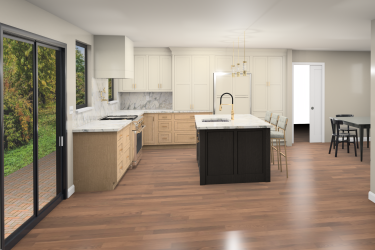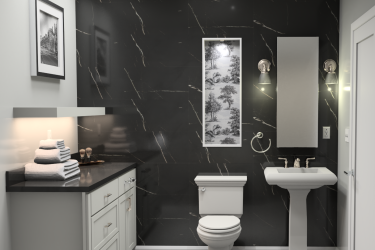Painted vs stained cabinets, having a hard time decided what’s best for you? Don’t worry, I have provided you with a complete guide to make your decision easy.
Painted vs Stained Cabinets – What would I do?
Most people are leaning one way or another based on personal preferences. Personally I love painted cabinets. Heck I love stained too. Especially walnut cabinets.
Because of my love for all things cabinetry I often marry the two. Typically I’ll do a lighter paint color such as white or gray on the perimeter with stained cabinets used for the kitchen island. The stained cabinet provides a warmer feel and breaks up the monotony.
What’s The Trend In Kitchen Cabinetry, Painted vs Stained Cabinets
You should know there is a massive painted cabinet trend out there. Today, almost 3 out of every four cabinets are painted. Of these the majority are white or off-white. Gray cabinets have been growing in popularity. We’re even seeing a wave of green kitchen cabinets. Just a few short years ago, it was the opposite, 3 out of 4 cabinets were stained. This is because many people prefer an all white kitchen and the clean look it portrays. It’s a timeless look. It also helps that costs have come down.
Painted vs Stained Cabinets Costs – What’s The Difference?
As with everything in cabinetry it depends. Most cabinet lines have a base wood species. This is usually maple or birch. Both of these species can be painted or stained.
Because maple and birch show much less grain than oak or walnut cabinets they are perfect for painting. The species provide more of a blank canvas. That makes your cabinet more about the paint color and less about the characteristics of the wood grain.
Now if you were to compare a maple stained cabinet versus a maple painted cabinet the stained cabinet would be more affordable. Typically you’ll see a paint uncharge of 15% for standard paints and 20% for custom paints. It is a more costly process comparatively. There are more steps involved. A well-made painted cabinet will have 2 coats of primer. The primer should match the color of the paint. Then your cabinet should get two coats of paint. Finally, there’s a top coat, put onto the paint. Compare this to staining a cabinet where there are two coats of stain finished with an oil based polyurethane.
Painting cabinets requires larger investments in shop equipment. High-end cabinet companies such as Plain & Fancy Cabinetry have massive warehouses filled with spraying machines. In-fact Plain & Fancy has imported their painting machine from Italy. They invested $4 million into their painting equipment.
How the cabinet is painted will impact pricing and the quality of the paint. If the cabinet is hung and manually painted with a sprayer you’re bound to see more imperfections in your cabinets. The proper way to paint cabinet doors and cases is by flat laying them. This will protect your cabinet from streaks.
Other factors to consider are the types of kitchen cabinets. The better understanding your designer has on how your kitchen is used on a daily basis the better they can guide you on all of these intricacies. Also not all cabinet companies do a great job with painted cabinets. You’ll want to check with your designer to ensure the cabinet company has a good reputation.
What’s Your Style?
It’s important to consider what type of overall look you want for your kitchen. Painted cabinets offer a sleek, clean design with a smooth, flawless finish. Classic white cabinets are the most popular color. Selecting cabinets with a painted finish opens up numerous color options for you to select from, unlike stained cabinets. Paint is thicker than stain and sticks well to the surface of the wood to covers knots and grains – making the focus on the color and not the texture of the cabinet.
Stained cabinets on the other hand are a great choice for homeowners who enjoy the look of wood grains and knots. Since stain is thinner than paint it soaks into the surface, giving the cabinet some color all while preserving the natural textures.
Also Read: Furniture Board vs Plywood Cabinets
You’ll also want to consider the type of flooring, countertop, and backsplash tiles for your kitchen. You’ll want to choose cabinets that flow with the rest of your selections. By working with a designer you’re likely to have a kitchen with a cohesive look.
What’s easier to maintained? Painted vs Stained Cabinets
When making a big investment on new cabinets you want to be sure that what you are buying will be easy to maintain and will hold up over the years. That being said, you should be aware that painted cabinets can show every day smudges and dirt more easily than a stained wood tone cabinet will. It’s also important to know it is possible for paint to chip if the cabinet is struck by a hard object. While you can get touch-up kits from some manufactures they may not blend well depending on the type of finish. On the other hand, it is much easier to find touch-up markers for stained cabinets. Even without an exact match you can often rely on the grains of the cabinet to help disguise a touch-up spot and help it to blend in.
Once you’ve put some thought into the pros and cons of each option it’s up to you to ultimately decide if you prefer painted kitchen cabinets or stained kitchen cabinets. Still need some help deciding? Our team of design experts can work with you to help create the kitchen of your dreams. Contact us today for a consultation.
What Is The Durability of Painted Cabinets?
Most importantly, it’s all in how the cabinets are finished. If you live in a mild climate or maintain your house between 65 and 75 degrees year-round then you can consider painted cabinets. However if you don’t have AC or keep your thermostat low in the winter you’ll likely want to avoid the idea. This is because wood is always in a state of expansion and contraction.
Painted cabinets will show imperfections such as hairline fractures more readily. Your cabinet door has joints. It’s where the stiles and rails connect. Usually they are joined through mortise and tenon construction at a 90 degree angle. Mitered joints meet at a 45 degree angle.
The stiles run vertically and the rails run horizontally. They meet to frame out the center panel of your cabinet door. The place where the stiles and rails join is most prone to hairline fractures. If you have a white cabinet you’re bound to see these fractures at some point. That’s even if you keep your house at a consistent temperature. Because the cabinets are white a crack is more apparent than if the cabinets were stained.





